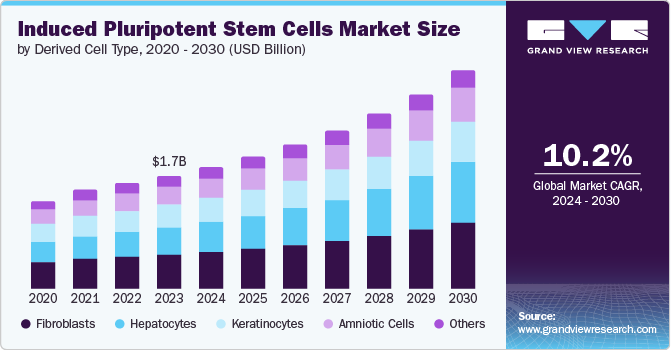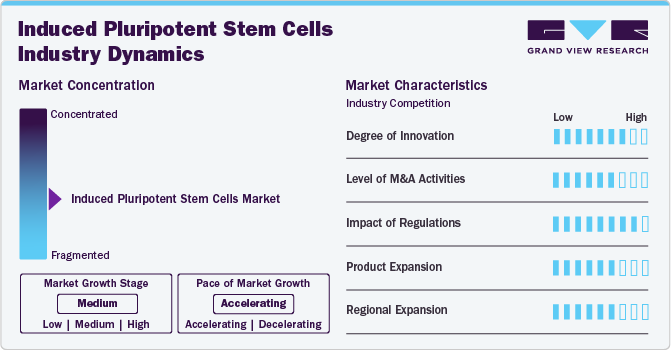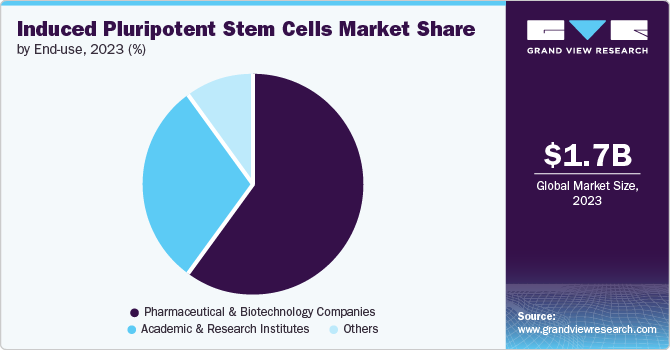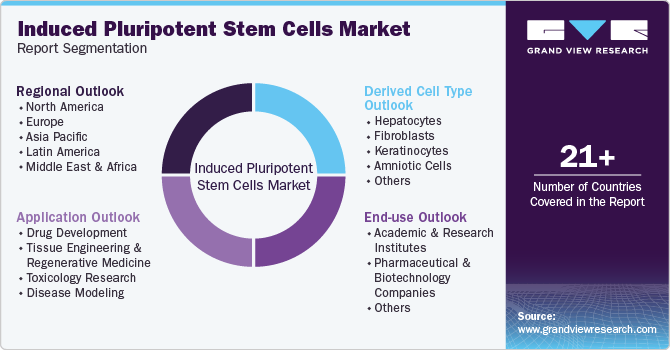
Induced Pluripotent Stem Cells Market Size, Share & Trends Analysis Report By Derived Cell Type (Hepatocytes, Fibroblasts), By Application (Drug Development), By End-use, By Region, And Segment Forecasts, 2024 - 2030
- Report ID: GVR-4-68040-116-1
- Number of Report Pages: 120
- Format: PDF
- Historical Range: 2018 - 2023
- Forecast Period: 2024 - 2030
- Industry: Healthcare
Market Size & Trends
The global induced pluripotent stem cells market size was estimated at USD 1.71 billion in 2023 and is projected to grow at a CAGR of 10.21% from 2024 to 2030. The rising prevalence of chronic diseases, increasing research and development activities in stem cell therapies, and growing focus on personalized medicine drive the iPSC market growth.

The distinct features of induced pluripotent stem cells include a wide range of biopharmaceutical applications. iPSCs are also employed for toxicological testing, disease modeling, and high throughput, including target selection. Induced pluripotent stem cell therapy is a revolutionary medical therapy used to treat cardiac arrhythmias and cancers of the liver, prostate, kidney, lung, and other organs. For instance, in January 2023, FUJIFILM Cellular Dynamics, Inc. announced the company signed an agreement to give Novo Nordisk A/S a non-exclusive license to use its iPSC platform for the development as well as distribution of iPSC-derived cell therapies with an emphasis on treating severe chronic diseases.
Moreover, rising government expenditure and increasing stem cell research are also expected to boost demand for induced pluripotent stem cells. For instance, in November 2020, FUJIFILM Cellular Dynamics, Inc. and Lonza Walkersville, Inc. announced a global agreement to utilize expertise and equipment to develop iPSCs.
Furthermore, the increased use of tailored medications for various therapies fuels the expansion of the iPSC market. A paper titled "Precision regenerative medicine," first published in Stem Cell Research & Therapy in January 2021, examined the rise of precision or personalized medicine in the medical and surgical fields. According to the report, induced pluripotent stem cells are essential in personalized medicine since they have various advantages over other stem cells.
Moreover, the increased number of induced pluripotent stem cell-based research investigations is significantly growing market growth. There are currently 175 clinical trials using iPSCs for disease interventions or developing iPSC products. Furthermore, regenerative medicine is witnessing continuous developments, and products have found use in several therapeutic applications. The advancement of accurate and convenient, innovative tools and solutions has led to pioneering technologies in regenerative medicine.
The COVID-19 pandemic profoundly impacted the iPSC production market due to the sharp increase in demand for iPSCs and its production services for research applications related to COVID-19. The cells provided a valuable platform to study the virus's effects on different cell types, screen potential treatments, and explore the long-term consequences of infection. Moreover, the pandemic highlighted the need for scalable & automated iPSC production technologies as conventional labor-intensive and manual processes were recognized as potential bottlenecks. As a result of the increased use, the demand for iPSC-based products is expected to grow in near future, which is likely to benefit the market in the long term.
Industry Dynamics
The induced pluripotent stem cell industry has seen significant innovation in recent years, with the introduction of advanced technologies that have improved the efficiency and accuracy of data analysis. For instance, in July 2024, Accelerated Bio and Pluristyx developed clinical-grade iPSCs from human trophoblast stem cells.
The industry is observing a significant level of merger & acquisition activities. In addition, companies are entering into collaborations and partnerships to develop new products and therapies. For instance, in September 2023, Lineage Cell Therapeutics partnered with Eterna Therapeutics, Inc. to generate a novel hypoimmune iPSC.

The regulatory impact significantly impacts the induced pluripotent stem cell industry. Regulatory authorities are focusing on establishing stringent guidelines for biosafety, contamination control, cell line authentication, and other factors. This compliance with regulatory standards represents significant challenges that may limit the market's growth.
The industry has seen significant growth in recent years, driven by the increasing research on iPSCs due to the rising demand for personalized medicine and increasing research & development activities focused on iPSCs. For instance, in March 2022, Cellular Engineering Technologies, Inc. received a patent from USPTO to develop, manufacture, and commercialize oncogene-free and virus-free iPSC technology.
The industry is experiencing a high level of regional expansion, indicating rapid growth and increasing market presence across different geographic regions. This expansion is driven by several factors, including the increased research and development focused on iPSCs for regenerative medicine, disease modeling, and drug discovery.
Derived Cell Type Insights
The fibroblasts segment held the largest market share of 30.51% in 2023. Fibroblasts are the skin's most accessible cells and have gained a focus in cell therapy. The dermal fibroblasts' regeneration capacity opens new avenues for developing cell-based therapeutics to treat skin problems. These cells are primarily responsible for synthesizing glycosaminoglycans and collagens, including extracellular matrix components that support the skin's structural integrity. Several preclinical investigations have revealed that allogeneic and autologous dermal fibroblasts can treat burn ulcers, wound healing, and hereditary skin problems. Induced pluripotent stem cells (iPSCs) derived from fibroblasts & gene-edited fibroblasts are thus potential treatments for treating skin problems, thus propelling market growth.
The hepatocytes segment is expected to grow at the fastest CAGR of 12.9% from 2024 to 2030. The rising prevalence of liver disorders, the growing adoption of a sedentary lifestyle, and the increasing consumption of alcohol are contributing to the market growth. According to the National Institutes of Health (NIH), in March 2023, one out of every 25 deaths globally was caused by liver disease, with two million deaths annually accounting for 4% of all deaths; almost two-thirds of all hepatic-related deaths are male.
Application Insights
The drug development segment held the largest market share of 49.03% in 2023. According to the WHO, 41 million people are killed by non-communicable diseases, such as cardiovascular disorders, cancer, chronic respiratory diseases, diabetes, etc., every year. This prevalence elevates the demand for disease research. Moreover, induced pluripotent stem cells are used in disease modeling, resulting in the development and discovery of novel treatment methods. For instance, market participants like Evotec SE have established an iPSC infrastructure providing a platform for efficient, robust, reproducible drug screening.
The tissue engineering & regenerative medicine segment is expected to grow at the fastest CAGR of 11.9% from 2024 to 2030. The applications of induced pluripotent stem cells for tissue development are in their early stages, owing to their ability to generate any cell or tissue in treating a wide range of diseases such as spinal cord injury, leukemia, or heart disease. These cells can potentially provide a genetic match for each patient. Furthermore, these cells are important in understanding the very early stages of human development and provide the ability to construct personalized, rejection-proof tissues and cells for transplantation. This is anticipated to contribute to the market’s growth.
End-use Insights
The pharmaceutical & biotechnology companies segment held the largest market share of 59.83% in 2023. Biotechnology and pharmaceutical businesses are investing in new product development to capitalize on the commercial opportunity of stem cell-based therapies. For example, Fate Therapeutics announced in October 2022 that it will present preclinical and clinical results from numerous iPSC product platforms at the Society for Immunotherapy of Cancer (SITC) meeting in November 2022. This highlights the market's substantial iPSCs product pipeline, supporting growth.

The academic & research institutes segment is expected to grow fastest at a CAGR of 10.9% over the forecast period. iPSCs are used in numerous academic and clinical studies due to their potential uses. The increasing use of iPSCs in regenerative investigations boasts therapeutic usage. For instance, in August 2020, the University of Minnesota extended its clinical exploration into the use of engineered iPSC-derived natural killer cells. The researchers initiated a clinical trial in the U.S. to explore the potential of these cells for treating COVID-19. In addition, in March 2022, Indiana University researchers collaborated with different organizations to examine the utilization of human iPSC to restore visual abilities in diabetic patients. Furthermore, the expanding research environment for assessing the safety & efficacy of iPSC-based treatments will likely fuel market expansion.
Regional Insights
North America dominated the market and accounted for a 36.11% share in 2023, owing to the robust research infrastructure related to novel therapeutics. Furthermore, the region benefits from substantial public and private funding for biotechnology and healthcare research and the expanding adoption of stem cell therapies.
U.S. Induced Pluripotent Stem Cells Market Trends
The induced pluripotent stem cells market in the U.S. is expected to grow over the forecast period due to the robust research and development landscape in biotechnology and life sciences, increasing innovation & technological advancements in stem cell therapeutics, strong support from regulatory authorities, and presence of key players in the country. In addition, the increasing number of clinical trials involving iPSCs fuels market growth.
Europe Induced Pluripotent Stem Cells Market Trends
The induced pluripotent stem cells market in Europe was identified as a lucrative region. Strong research and development in biology, pharmaceuticals, and therapeutics, along with the presence of key market players in the region, are factors driving market growth.
The UK induced pluripotent stem cells market is expected to grow over the forecast period. Rising demand for cell therapy and the increased prevalence of chronic and hereditary diseases drive market growth. In addition, the country benefits from a robust regulatory framework, further driving market growth.
The induced pluripotent stem cells market in Germany is expected to grow over the forecast period, driven by technological advancements, increasing stem cell research, and the rising demand for personalized therapies.
France induced pluripotent stem cells market is anticipated to grow over the forecast period. France is focusing on increasing the number of stem cell clinical trials. Moreover, the developing research infrastructure and collaborations between local companies and research institutes are anticipated to aid the market's growth.

Asia Pacific Induced Pluripotent Stem Cells Market Trends
The induced pluripotent stem cells market in Asia Pacific is anticipated to witness the fastest CAGR of 12.3% from 2024 to 2030. The fast growth is due to increased government support in the healthcare industry and increasing awareness about cell therapies and personalized medicine.
Japan induced pluripotent stem cell market is anticipated to grow significantly over the forecast period. The market’s growth can be attributed to the rapid technological advancements in stem cell research and well-defined regulatory policies for research on iPSCs.
The induced pluripotent stem cells market in China is expected to grow over the forecast period owing to the growing scope of stem cells R&D and numerous scientific advancements in medical applications. Furthermore, the social & political environment in China offers a favorable and liberal environment for human stem cell research. The Ministry of Science & Technology has established four stem cell banks covering the East, South, and North of China. Hence, with social, legal, and government support, China is expected to witness rapid growth and advancements in the induced pluripotent stem cell market.
India induced pluripotent stem cells market is anticipated to grow rapidly over the forecast period. With the increasing burden of diseases such as cancer and diabetes in the country, there is a growing demand for advanced therapeutics like stem cell therapy. In addition, India’s large population and rising healthcare awareness are driving factors for adopting innovative technologies in the medical field.
Middle East And Africa Induced Pluripotent Stem Cells Market Trends
The induced pluripotent stem cells market in the Middle East and Africa is projected to grow during the forecast period. Factors such as economic conditions, technological advancements, regulatory environment changes, consumer preferences, and competitive landscape dynamics are likely to influence the market in this region.
Saudi Arabia induced pluripotent stem cells market is expected to grow over the forecast period due to the substantial investment in biotechnology & medicine, increased research activities, and government initiatives supporting scientific advancements. Furthermore, Saudi Arabia was the first Arabian country to have more than 10,000 stem cell donors. This indicates increasing adoption of stem cell therapies in the country, which is expected to drive the market.
The induced pluripotent stem cell market in Kuwait is expected to grow significantly in the coming years due to the increasing focus on stem cell therapies and stem cell transplants nationwide. The country has numerous stem cell transplant programs. Furthermore, the increase in the number of new cancer cases is driving the growth of the stem cell market in Kuwait.
Key Induced Pluripotent Stem Cells Company Insights
Key players operating in the market are undertaking various initiatives to strengthen their market presence and increase the reach of their products and services. Strategies such as expansion activities and partnerships play a key role in propelling the market growth.
Key Induced Pluripotent Stem Cells Companies:
The following are the leading companies in the induced pluripotent stem cells market. These companies collectively hold the largest market share and dictate industry trends.
- STEMCELL Technologies Inc.
- Cellular Engineering Technologies Inc.
- REPROCELL Inc.
- Takara Bio, Inc.
- Axol Bioscience Ltd.
- Fate Therapeutics, Inc.
- FUJIFILM Cellular Dynamics, Inc.
- Cynata Therapeutics Limited
- Evotec SE
- Astellas Pharma Inc.
Recent Developments
-
In April 2024, Shinobi, a manufacturer of iPSC-derived cell therapy, collaborated with Panasonic and Kyoto University, Japan, to develop a platform for iPS-T cell therapies.
-
In January 2024, the Abu Dhabi Stem Cells Centre (ADSCC) and the Kyoto University, Japan, collaborated to develop a new therapy against diabetes that uses pancreatic beta cells derived from human induced pluripotent stem cells.
-
In October 2023, STEMCELLS Technologies, Inc. announced the opening of its new facility in Ontario, leveraging its North American market presence.
-
In October 2023, QHP Capital acquired Applied StemCell, which was expected to scale up the manufacturing of various types of cells, including iPSCs.
-
In September 2023, Ushio, Inc. collaborated with Axol Bioscience as its supplier for iPSC-derived sensory neuron cells. This new contract allowed Ushio to use human iPSC-derived axoCells sensory neurons in its in vitro Nerve Plate platform.
-
In February 2023, Lineage Cell Therapeutics, Inc. collaborated with Eterna Therapeutics, Inc. to develop beta 2 microglobulin (B2M)-deficient iPSC lines. The new cell lines to be developed by Eterna would elevate Lineage’s product portfolio in treating certain CNS disorders and other neurology indications.
-
In January 2022, Bristol-Myers Squibb Company entered a strategic collaboration with Century Therapeutics to develop iPSC-derived allogeneic cell therapy. This initiative was expected to enhance the company’s stem cell offerings.
Induced Pluripotent Stem Cells Market Report Scope
|
Report Attribute |
Details |
|
Market size value in 2024 |
USD 1.84 billion |
|
Revenue forecast in 2030 |
USD 3.31 billion |
|
Growth rate |
CAGR of 10.21% from 2024 to 2030 |
|
Actual data |
2018 - 2023 |
|
Forecast period |
2024 - 2030 |
|
Report updated |
August 2024 |
|
Quantitative units |
Revenue in USD million/billion and CAGR from 2024 to 2030 |
|
Report coverage |
Revenue forecast, company ranking, competitive landscape, growth factors, and trends |
|
Segments covered |
Derived cell type, application, end-use, region |
|
Regional scope |
North America; Europe; Asia Pacific; Latin America; MEA |
|
Country scope |
U.S.; Canada; Mexico; Germany; UK; France; Italy; Spain; Denmark; Sweden; Norway; China; Japan; India; South Korea; Australia; Thailand; Brazil; Argentina; South Africa; Saudi Arabia; UAE; Kuwait |
|
Key companies profiled |
STEMCELL Technologies Inc.; Cellular Engineering Technologies Inc.; REPROCELL Inc.; Takara Bio, Inc.; Axol Bioscience Ltd.; Fate Therapeutics, Inc.; FUJIFILM Cellular Dynamics, Inc.; Cynata Therapeutics Limited; Evotec SE; Astellas Pharma Inc. |
|
Customization scope |
Free report customization (equivalent up to 8 analysts working days) with purchase. Addition or alteration to country, regional & segment scope. |
|
Pricing and purchase options |
Avail customized purchase options to meet your exact research needs. Explore purchase options |
Global Induced Pluripotent Stem Cells Market Report Segmentation
This report forecasts revenue growth at global, regional, and country levels and provides an analysis of the latest industry trends in each of the sub-segments from 2018 to 2030. For this study, Grand View Research has segmented the global induced pluripotent stem cells market report based on derived cell type, application, end-use, and region:

-
Derived Cell Type Outlook (Revenue, USD Million, 2018 - 2030)
-
Hepatocytes
-
Fibroblasts
-
Keratinocytes
-
Amniotic Cells
-
Others
-
-
Application Outlook (Revenue, USD Million, 2018 - 2030)
-
Drug Development
-
Tissue Engineering & Regenerative Medicine
-
Neurology
-
Orthopedics
-
Oncology
-
Cardiovascular and Myocardial Infraction
-
Diabetes
-
Others
-
-
Toxicology Research
-
Disease Modeling
-
-
End-use Outlook (Revenue, USD Million, 2018 - 2030)
-
Academic & Research Institutes
-
Pharmaceutical & Biotechnology Companies
-
Others
-
-
Regional Outlook (Revenue, USD Million, 2018 - 2030)
-
North America
-
U.S.
-
Canada
-
Mexico
-
-
Europe
-
Germany
-
UK
-
France
-
Italy
-
Spain
-
Denmark
-
Sweden
-
Norway
-
-
Asia Pacific
-
Japan
-
China
-
India
-
South Korea
-
Australia
-
Thailand
-
-
Latin America
-
Brazil
-
Argentina
-
-
MEA
-
South Africa
-
Saudi Arabia
-
UAE
-
Kuwait
-
-
Frequently Asked Questions About This Report
b. The global induced pluripotent stem cells market size was estimated at USD 1.71 billion in 2023 and is expected to reach USD 1.85 billion in 2024.
b. The global induced pluripotent stem cells market is expected to grow at a compound annual growth rate of 10.21% from 2024 to 2030 to reach USD 3.31 billion by 2030.
b. The fibroblasts segment held the largest market share of 30.51% in 2023. Fibroblasts are the skin's most accessible cells and have received a lot of interest in cell therapy.
b. Some prominent players in the global induced pluripotent stem cells market include STEMCELL Technologies Inc., Cellular Engineering Technologies Inc., REPROCELL Inc., Takara Bio, Inc., Axol Bioscience Ltd., Fate Therapeutics, Inc., FUJIFILM Cellular Dynamics, Inc., Cynata Therapeutics Limited, Evotec SE, Astellas Pharma Inc.
b. The market for induced pluripotent stem cells (iPSCs) is driven by the increased use of stem cell therapies, a growing biotechnology industry with better investment opportunities, and an increase in the prevalence of chronic diseases. The wide range of clinical applications of induced pluripotent stem cells and new technological developments of iPSCs are additional drivers that are projected to fuel the expansion of the global induced pluripotent stem cells market.
We are committed towards customer satisfaction, and quality service.
"The quality of research they have done for us has been excellent."




